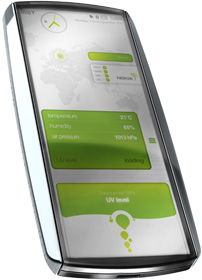Tuesday Topsight, December 18, 2007
 Hey there, folks out there in Internet-land -- do you find these "topsight" posts useful or interesting? I sometimes puzzle over whether the various individual entries would be better off as individual short posts, rather than as a catch-all post. The downside of that is my apparent inability to keep individual posts terse. The upside would be clearer topics and easier inbound links, should you find yourself wanting to point to a particular item.
Hey there, folks out there in Internet-land -- do you find these "topsight" posts useful or interesting? I sometimes puzzle over whether the various individual entries would be better off as individual short posts, rather than as a catch-all post. The downside of that is my apparent inability to keep individual posts terse. The upside would be clearer topics and easier inbound links, should you find yourself wanting to point to a particular item.
Opinions? Ideas? Bueller?
• Prototyping the Participatory Panopticon, Part 1: Waaaaaay back in the dark days of early 2006, I gave a little talk at the TED conference on the idea of an "Earth Witness" program, with sensing devices built into mobile phones to allow for collaborative environmental science. Nice talk, Al G liked it, but it wasn't flashy enough for the TED talk public listing. Anyway, the notion of an enviro-phone seemed possible but not necessarily plausible back then -- but now Nokia is running with the idea, and showcasing its "Eco Sensor" concept phone.
To help make you more aware of your health and local environmental conditions, the Nokia Eco Sensor Concept will include a separate, wearable sensing device with detectors that collect environment, health, and/or weather data.You will be able to choose which sensors you would like to have inside the sensing device, thereby customizing the device to your needs and desires. For example, you could use the device as a “personal trainee” if you were to choose a heart-rate monitor and motion detector (for measuring your walking pace).
Here are some other examples of customized sensing devices you could build:
Environmental monitoring
- Atmospheric gas-level monitor (including carbon monoxide, particulate matter, and ground-level ozone detectors, for example)
- Ultraviolet radiation sensor
- Subscription to environmental catastrophe warning and guidance system
Personal health
- Motion detector
- Heart rate monitor
- Noise level monitor
Weather monitoring
- Air pressure sensor
- Humidity sensor
- Temperature sensor
- Subscription to environmental catastrophe warning and guidance system
This isn't a phone that's being prepped for sale, it's a "hey look at how cool and green we are" design that won't make it out of the lab -- at least in this form. (Quick aside: we've had concept cars for awhile, and concept computer designs -- although rarely from the manufacturers. Now we have concept phones. What's next?) But like concept cars, the technologies deployed in this model can end up in shipping units a year or three down the road.
• Prototyping the Participatory Panopticon, Part II: When talking about the various technologies of the participatory panopticon, I usually make a point of mentioning that the "offloaded memory" functions of PP devices could be particularly appealing to aging populations. Seems I'm not the only one:
When Mrs. B was admitted to the hospital in March 2002, her doctors diagnosed limbic encephalitis, a brain infection that left her autobiographical memory in tatters. As a result, she can only recall around 2 percent of events that happened the previous week, and she often forgets who people are. But a simple device called SenseCam, a small digital camera developed by Microsoft Research, in Cambridge, U.K., dramatically improved her memory: she could recall 80 percent of events six weeks after they happened, according to the results of a recent study.
A wearable camera, the SenseCam takes a shot every 30 seconds, and makes the collected images available for later viewing. What I didn't expect -- and is a wonderful result -- is that by examining the recorded images, the user could move those digital memories to long-term brain memory.
Here's an important guideline for people thinking about technology futures: look at the needs the aging and disabled have yet to have filled. As the baby boom in the west hits retirement age -- and especially as the even larger demographic bulge in China moves to retiree status -- we'll see an explosion of demand for the kinds of technologies to help the active disabled and active elderly maintain personal and social flexibility.
In other words, this is just the beginning.
(Via MedGadget)
• Moving Down the Apocalypse Scale: One of the most-linked items I've ever posted here is my "eschatological taxonomy," a scale of different levels of apocalypse -- from regional destruction all the way through to the total elimination of the planet. Fun stuff.
Jason Matheny, at the Bloomberg School of Public Health at Johns Hopkins University, gives the notion of dealing with the end of the world a more thorough examination. In his "Reducing the Risk of Human Extinction," just published in the academic journal Risk Analysis, Matheny gives a detailed account of possible ways the human race (and its descendants) could end, and what we might be able to do about it. Most interesting for me was his discussion of "discounting," that is, how the value of future human lives varies from the value we place on present-day human life. It's a fairly deep philosophical question done up in economics drag.
Even if extinction events are improbable, the expected values of countermeasures could be large, as they include the value of all future lives. This introduces a discontinuity between the CEA of extinction and nonextinction risks. Even though the risk to any existing individual of dying in a car crash is much greater than the risk of dying in an asteroid impact, asteroids pose a much greater risk to the existence of future generations (we are not likely to crash all our cars at once) (Chapman, 2004 ). The "death-toll" of an extinction-level asteroid impact is the population of Earth, plus all the descendents of that population who would otherwise have existed if not for the impact. There is thus a discontinuity between risks that threaten 99% of humanity and those that threaten 100%.
This is a very interesting piece, and definitely adds to the ongoing conversation about how best to allocate scarce resources for resilience.
(Bonus! It turns out that Matheny is also involved with New Harvest, the leading organization working on the development of cruelty-free meat!)
• Oh, No Revisted: When it's not advertisers trying to beam audio messages into your skull, it's political campaign specialists trying to figure out how to manipulate your emotions. Campaigns & Elections magazine has an article entitled "Mind games: how campaigns of the future will play with your brain," looking at the various new technologies that could influence how political campaigns of tomorrow would be run.
Campaign ads that break through the filters could pack more punch, thanks to the nascent field of neuromarketing. The field is based on scientific research on what messages make the human brain light up in which areas--and what those lights mean. For instance, a campaign might look to craft a message that is sure to evoke a warm, fuzzy feeling about a candidate. Opponents might try to instill the opposite."It comes down to making sure that what is being said by the candidates or by the party has been crafted specifically to elicit particularly neurochemical responses," said Cascio, the San Francisco futurist. He envisions Democratic and Republican neuromarketing firms crafting dueling messages in the heat of a campaign.
(Uh, yeah, they quote me -- but also some other names you might recognize, including Zephyr Teachout, Jason Tester from IFTF, and David Brin.)
Of course, this all leads to the inevitable conclusion:







Comments
I enjoy the "topsight" posts. I try to keep up on 215 different blog feeds, and it's more efficient for me to read the topics packaged together like this.
Of course, I'd keep reading regardless. Your blog is fascinating and one of my favorites.
Posted by: Bill LaLonde | December 19, 2007 4:59 AM
Vote: individual posts
I use Google Reader to read my feeds and I share/star/tag the posts I want to find later. If a post is about one topic it's much easier to properly save it, and to figure out later why I saved it.
Posted by: Eaglewing | December 19, 2007 7:42 AM
I like the topsight format because it is quick plus it feels as a nice snapshot of what is happening on the future front. I realise that this feeling might be false sometimes (the human brain loves to relate the unrelated) but I don't want to give it up anyway.
Posted by: Alexandr Kazda | December 19, 2007 1:05 PM
Extinction comment: I have difficulty buying into the concept of placing a large value on future lives, at least beyond one or two generations (our children and our children’s children). It seems like a religious argument. You could just as easily say using contraceptives is not valuing future lives. The concept of adopting the whole future human race as honorary children might seem a lofty concept, but it doesn’t seem to gel with how we are evolutionary programmed. “For the good of the species” is not an evolutionary argument (though this is often misunderstood) - perhaps a libertarian one?
I guess responding to one part of a compilation blog entry also highlights one potential issue with it.
Posted by: John B Stone | December 19, 2007 2:50 PM
Re John B Stone: I think that the point of the extinction comment wasn't that we should always consider future population. The point is that there is a huge jump in damage done between events killing most of humanity and events killing all of humanity and so we should think about the latter more than usual insurance-style math would indicate.
While I don't feel any personal connection to humans from 2100, I do hope that various ideas I value (namely knowledge and freedom) will be still held in high esteem by this time. If by 2100 there will only a few hundred thousand of us, it will be sad. If the population of Earth will be zero, all our work, history and culture is lost, an ultimate failure. Evolutionary, I suppose that memes are at work here, instead of genes.
Posted by: Alexandr Kazda | December 20, 2007 12:19 PM
How do you decide what to put in a main post versus what to put in a topsight? One useful criteria would be to reserve large posts for your work (or for things you want to work on), and save the topsight for cool news. If you don't have a criteria, my advice is to treat them all as regular posts, just to improve searchability.
Posted by: John the Statistician | December 21, 2007 4:51 AM
My vote: individual posts - easier for me to skim, ergo more likely that I'll stop to read the one or two items that I *really* want to see rather than reacting, "Oh, hey, that's long" and moving on.
'Cuz I'm a blog butterfly that way . . .
Posted by: Tim | December 21, 2007 12:14 PM
The dirty secret is that my main reason for deciding what goes into a topsight post is just how many interesting things have built up in my queue.
Maybe I'll keep topsight as a category, and try to keep the individual posts terse, but split them up for better searching.
Posted by: Jamais Cascio | December 21, 2007 1:39 PM